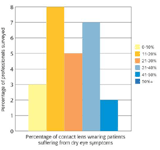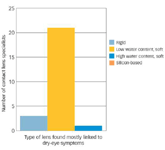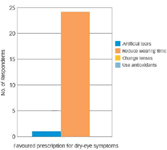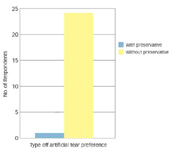Article
Contact induced dry eye
Understanding the problems of contact lens induced dry eye
Within the general population, moderate dryeye problems can be triggered by many factors including: nutrition, ageing, medications and environmental conditions. While as low as 10% of noncontact lens wearers under the age of 60 are reported to suffer from dry eye; dryness is one of the most common problems reported by contact lens wearers and in extreme cases can lead to contact lens drop out.1
To better understand the problems of contact lens induced dry eye (CLIDE) in Sweden, we sent out a survey to 25 leading Swedish contact lens fitters with the following questions:2
Q: What percentage of your contact lens wearing patients suffer from dry eye symptoms?
Q: What is your favourite prescription for solving dry-eye symptoms?
Q: If you ask your CLIDE patients to use artificial tears, do you prefer preserved or nonpreserved products?
The results from the Swedish survey were calculated and compared to results from a similar study completed in Germany.3

Ninety-two percent (n=23) of the contact lens specialists felt that high water (>50% water) soft contact lenses were the main contributor to CLIDE. In the similar German study over 40% of respondents felt the same.

Regarding which type of artificial tear is preferred, 96% (n=24) preferred to prescribe a nonpreserved product. The German study showed very similar results.


Newsletter
Don’t miss out—get Ophthalmology Times updates on the latest clinical advancements and expert interviews, straight to your inbox.




